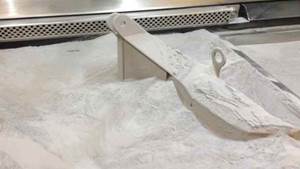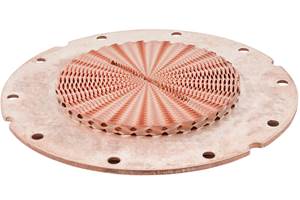How Investing in Metal AM Is Different
GE Capital helps manufacturers finance additive manufacturing equipment, but the investment goes beyond the 3D printer. Production AM demands a production infrastructure, and requires a long-term strategic approach.
Share
As a rapid prototyping technology, 3D printing can be thought of as another tool. It may be a much faster tool, and perhaps displaces some of the tools that came before it, but it is primarily an addition to a design department, rather than a disruption to it.
But the closer that 3D printing is to production, the more disruptive it becomes. A filament printer creating scale models on an engineer’s desk is a far cry from a laser-sintering machine manufacturing jet engine parts from titanium powder. The first fits into an existing system; the second demands a new one. The successful pursuit of additive manufacturing requires installing that AM capacity within a process that also considers design, material, quality control and data management in light of the new mode of production.
If that sounds daunting, that’s because it is. One reason that GE, for example, has been successful at leveraging metal AM for production parts is that it also has the resources to refashion its supply chain around those parts. But what about manufacturers that don’t operate at the scale of GE? How can they effectively move into AM for production?
This gap is one of the current focuses for GE Capital, the financial arm of GE that is closely aligned with both GE Additive and AddWorks, its AM consultancy branch. “We have a dual mission to help customers get started and then scale with additive manufacturing,” says Byrne Huddleston, commercial leader at GE Capital. “Because of our close relationship with GE Additive, we can leverage what we already know to expedite bringing customers up to speed.”
One of these customers that has rapidly advanced into AM is Proto Precision Manufacturing Solutions, an Ohio-based precision fabricator that recently acquired its first metal AM machines. The company chose to purchase an Arcam Q10+ and Concept Laser M2 cusing system from GE Additive, which were recently installed at The Ohio State University’s Center for Design and Manufacturing Excellence. “We were looking for a vendor that had a strong additive manufacturing background, beyond just the machine,” says Sugu Suguness, managing partner. GE’s ability to offer equipment, materials and financing helped drive Proto Precision’s purchase design, and the entire process from first meeting to machine installation in less than 6 months.
Huddleston says there are a number of points manufacturers thinking about AM for production should consider before making a purchase:
Production AM represents a significant investment beyond the machinery. Initially this includes auxiliary equipment such as powder handling and postprocessing equipment, the material itself, and safety infrastructure. It may also include software, postprocessing and inspection equipment. There’s also staffing and training to consider, to develop the internal experience necessary to run the equipment successfully.
“There’s a lot to consider and plan for before printing your first piece,” Suguness says. “In addition to identifying a space that can safely house the equipment, it takes time to finalize the transaction, ship the assets and supplies, install the asset, and learn how to use it properly. You can’t simply plug it in and click the ‘print’ button.”
Needs change as scale increases. An established company, such as a machine shop that already has capacity to inspect and finish-machine metal parts, may only need the bare minimum of equipment to get started manufacturing with a metal 3D printer. But that company should also be prepared to expand flexibly as its operation scales up. As quantities grow it may make sense to add more printers and postprocessing equipment, or to integrate advanced equipment such as CT scanners or uninterruptible power supply (UPS) units to ensure print quality in areas where power access may be spotty.
AM equipment lends itself toward a flexible upgrade cycle. “It’s not really like the CNC machining world, where you might buy the machine and keep it forever,” Huddleston says. While that might sometimes happen with AM equipment, he says that his customers are often eager to keep up with rapidly changing technologies. That’s why GE Capital offers a lease structure that allows customers to upgrade their equipment at the end of term. “We’ve tried to create an easy upgrade cycle, more like the technology market,” he says. Flexibility in financing at the outset enables users to capitalize on future technology advances.
Metal AM is a long-term strategic investment. One mistake that manufacturers make is “considering the machine purchase as a transaction, instead of a long-term strategic investment,” Huddleston says. Companies may be able to integrate a metal 3D printer with minimal disruption, but they risk only getting minimal value out of the investment. With AM, value is created by designing the entire system around the process. “Moving forward without clear planning will make it difficult,” he says. “It will ultimately take longer to get to the point of certification or production.”
Production AM demands a production infrastructure. Again, the best use of AM is to build processes around it, not force it into an existing supply chain. The technology makes the most business sense for production when it is used to manufacture AM-design-optimized parts from AM-validated materials, under proven AM parameters. Companies that succeed at scale will be those invested in the technology and understanding its best use cases. “For many customers this means a culture change, as well as a paradigm shift in how they design and engineer,” Huddleston says.
That shift in thinking is already happening at many companies, but there is more change to come. Part of the reason that Proto Precision chose to install its GE Additive machines at OSU, where engineering students will have access to them, is to help spark students’ interest in metal AM. “This is an emerging technology and will change the way we build equipment,” Suguness says. “We think it’s incredibly important for the next generation of manufacturers to learn about additive manufacturing.” At some point soon, future manufacturing professionals will enter the workforce already prepared to accept additive manufacturing for production, no disruption required.
Related Content
Additive Manufacturing Is Subtractive, Too: How CNC Machining Integrates With AM (Includes Video)
For Keselowski Advanced Manufacturing, succeeding with laser powder bed fusion as a production process means developing a machine shop that is responsive to, and moves at the pacing of, metal 3D printing.
Read MorePostprocessing Steps and Costs for Metal 3D Printing
When your metal part is done 3D printing, you just pull it out of the machine and start using it, right? Not exactly.
Read MoreWith Electrochemical Additive Manufacturing (ECAM), Cooling Technology Is Advancing by Degrees
San Diego-based Fabric8Labs is applying electroplating chemistries and DLP-style machines to 3D print cold plates for the semiconductor industry in pure copper. These complex geometries combined with the rise of liquid cooling systems promise significant improvements for thermal management.
Read MoreDMG MORI: Build Plate “Pucks” Cut Postprocessing Time by 80%
For spinal implants and other small 3D printed parts made through laser powder bed fusion, separate clampable units resting within the build plate provide for easy transfer to a CNC lathe.
Read MoreRead Next
3D Printed Polymer EOAT Increases Safety of Cobots
Contract manufacturer Anubis 3D applies polymer 3D printing processes to manufacture cobot tooling that is lightweight, smooth and safer for human interaction.
Read MoreProfilometry-Based Indentation Plastometry (PIP) as an Alternative to Standard Tensile Testing
UK-based Plastometrex offers a benchtop testing device utilizing PIP to quickly and easily analyze the yield strength, tensile strength and uniform elongation of samples and even printed parts. The solution is particularly useful for additive manufacturing.
Read MoreBike Manufacturer Uses Additive Manufacturing to Create Lighter, More Complex, Customized Parts
Titanium bike frame manufacturer Hanglun Technology mixes precision casting with 3D printing to create bikes that offer increased speed and reduced turbulence during long-distance rides, offering a smoother, faster and more efficient cycling experience.
Read More
.jpg;width=70;height=70;mode=crop)



















